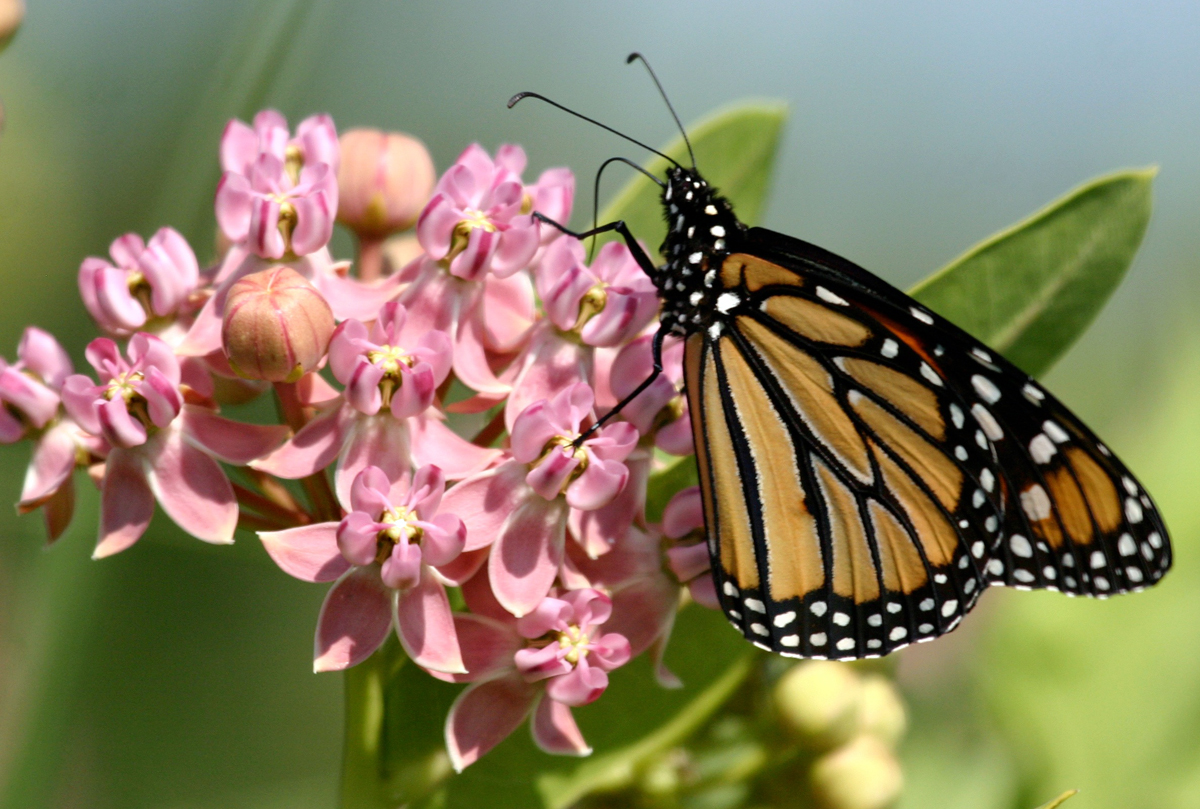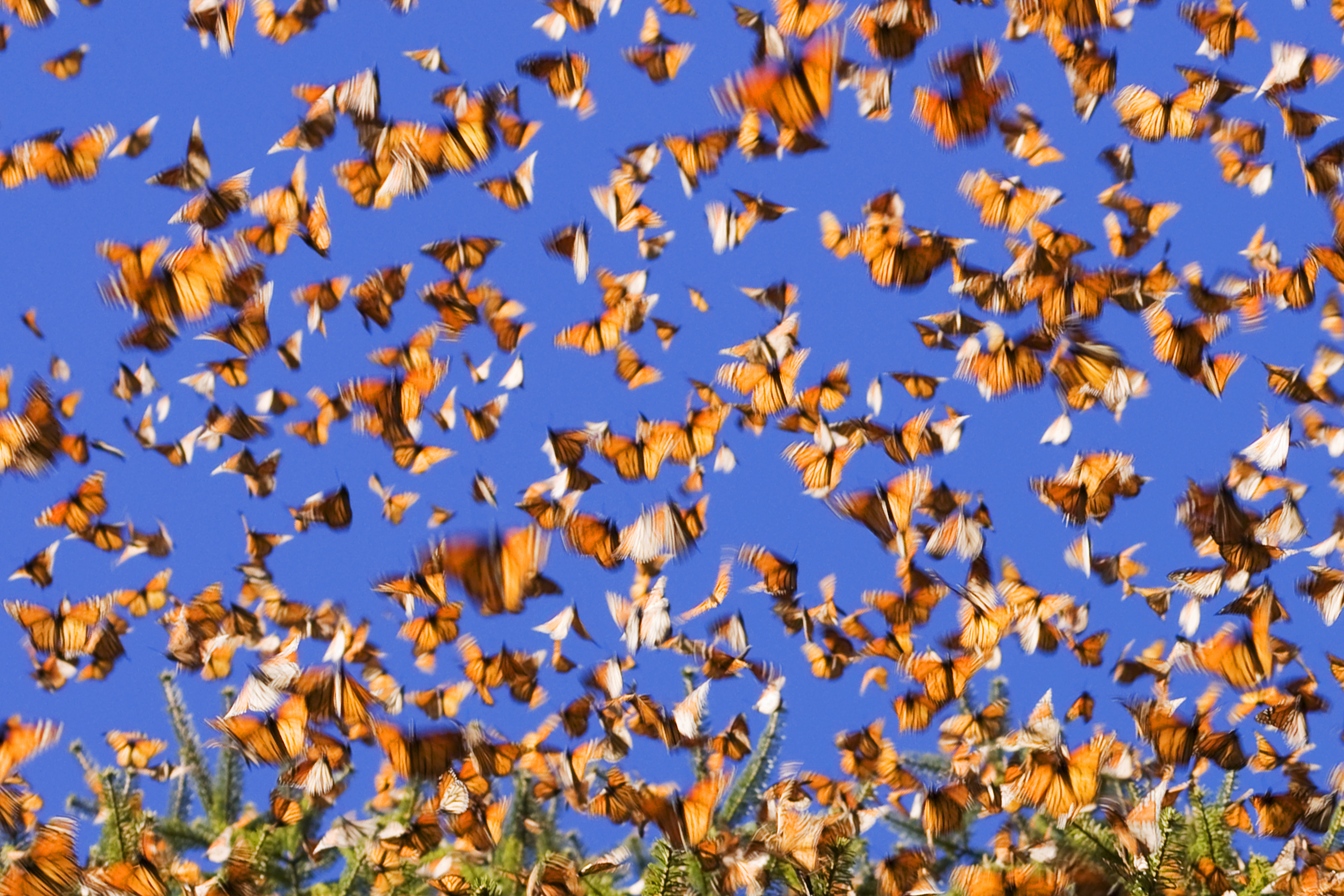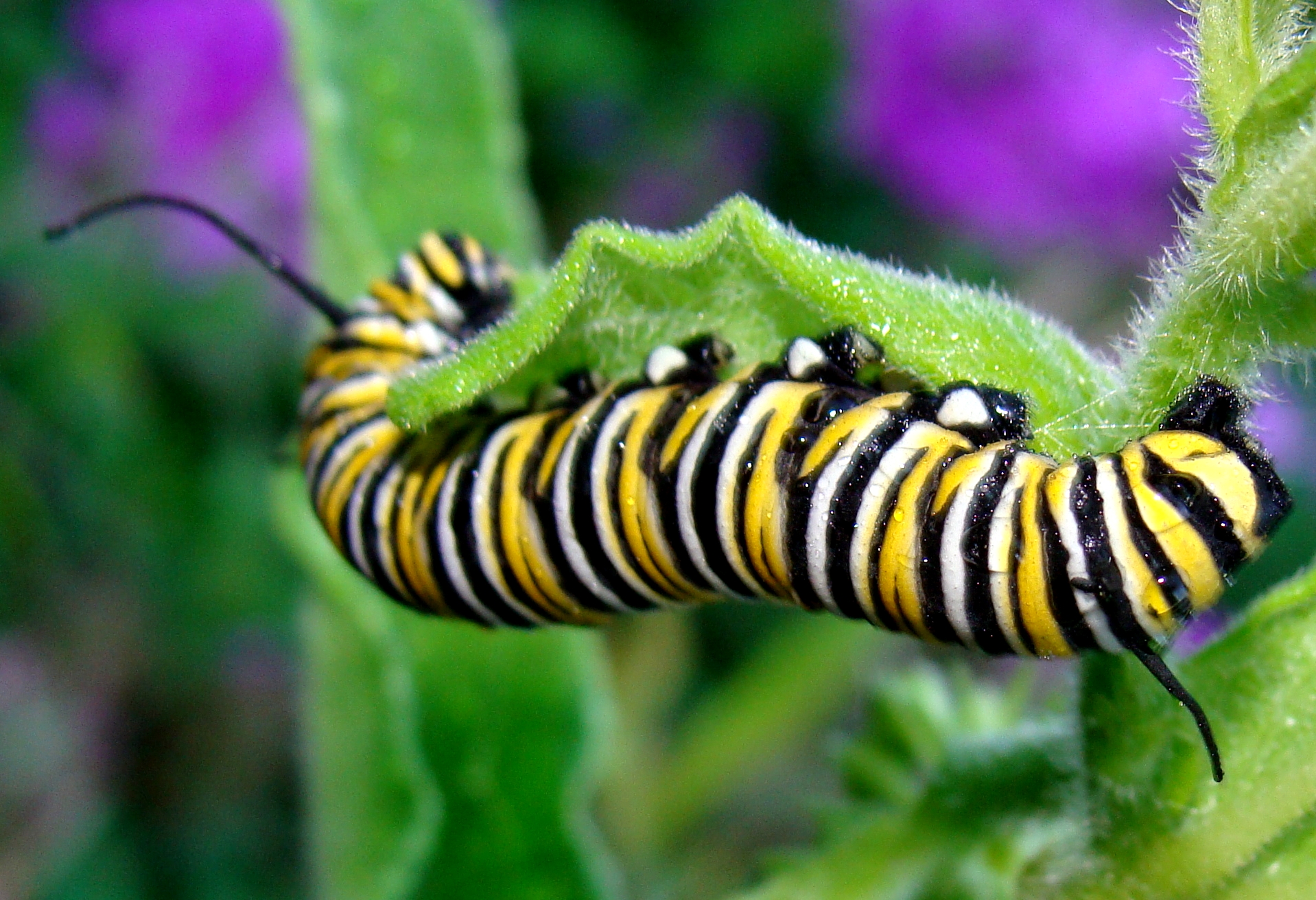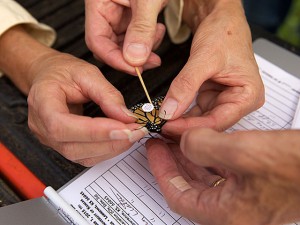It is early September in Wisconsin, and a little black-headed caterpillar hatches from her egg. The days are getting shorter and the temperatures are falling, especially during the night. A complex interplay between these outside conditions and the caterpillar’s genes will trigger reproductive rest: when she turns into an adult monarch butterfly, she will be unable to mate. Instead, she will devote all of her energy to migration, completing a 2,000-mile journey from Wisconsin to her winter home in central Mexico.
Three months before the caterpillar wriggled out of her egg, Gary Hess was combing through his 20-acre property, carefully turning over certain lush green leaves. It was Memorial Day weekend and Gary was on a mission. Instead of celebrating the start of summer with a family barbecue, his personal harbingers of the new season were tiny white eggs on the underside of a milkweed leaf.
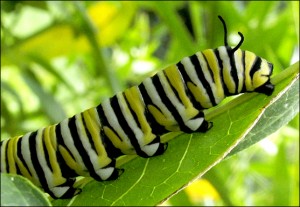
A monarch caterpillar munches on milkweed, the only food it can eat. Photo by Virginia Arboretum, via Flickr/Creative Commons.
There! He finally found what he was looking for and eagerly shared his excitement with Darcy, his wife of 30 years. From now on, the couple would spend much of their free time raising hundreds of monarch butterflies inside their home near Beloit, in south central Wisconsin. Why? Because their tender, loving care bumps the chances that any one egg will become an adult butterfly from a mere four percent in nature to as much as 80 percent.
“If you can bring them in as an egg and raise them to a butterfly, you’ve really given them a head start,” Gary says. “That’s why we do it.”
Wisconsinites are better known for raising dairy cows than monarch butterflies. But because human activities have endangered the iconic North American insects, the time for giving them a head start has never been better.
Monarchs are in trouble for two reasons: as caterpillars, they rely on a single food source — milkweed — that has become scarce; and as butterflies, their unique migration makes them vulnerable to the effects of habitat loss and a changing climate — not just in Wisconsin, but in an entire corridor from southern Canada to northern Mexico.
Caterpillars along the driveway
Gary and Darcy moved into their house in rural Wisconsin in 2003. They were nature lovers already and had decided to let their land grow wild. The more milkweed plants that appeared along their driveway, the more they started to notice the curiously striped caterpillars munching on them. They brought some of them inside “just for fun,” Gary says.
But they soon found themselves fascinated with the monarch’s metamorphosis — the orchestrated series of changes that transform a fat, striped caterpillar into an orange canvas of a butterfly embellished with strokes of black and white.
So Gary and Darcy started to read up on monarchs. It didn’t take them long to learn that the insects were struggling. One of the organizations that kept coming up in their online searches was Monarch Watch, a nonprofit founded by Orley “Chip” Taylor, a professor in the Department of Ecology and Evolutionary Biology at the University of Kansas.
Taylor says Monarch Watch grew out of a tagging program he created in 1992, but when Gary and Darcy learned about the organization, tagging was no longer the only kind of conservation effort it sponsored. Gary and Darcy joined the Monarch Waystation program in 2008 and tagged monarchs for the first time in 2011.
Tagging solves a decade-old mystery
Tagging involves catching a monarch in early fall, usually by hand, to place a small vinyl sticker on the underside of one of its wings. Some of the tags are eventually retrieved at the insects’ overwintering site, about 60 miles northwest of Mexico City, providing clues about their state of origin and the duration of their journey.
Four decades ago, the value of tagging was proven by Canadian zoologist Fred Urquhart and his wife, Norah, who solved a mystery that Fred had been obsessed with since his childhood: where exactly did the monarchs go for the winter, and did the same individuals return north the following spring?
The Urquharts had a few helping hands in solving this puzzle.
“In 1952, [Urquhart] issued the first appeal for volunteers to assist with the tagging, and over the next 20-odd years, thousands of people had participated,” the University of Toronto wrote in an obituary for Urquhart. “In January 1975, these efforts paid off when Ken and Cathy Brugger of Mexico City called to tell Urquhart they’d found millions of monarchs … In 1976, the Urquharts were able to see the spectacular sight for themselves.”
So was Randy Korb of St. Croix Falls, Wisconsin, about 15 years later than the Urquharts. Korb has contributed to monarch conservation for many years by leading butterfly presentations in public schools around the state and helping families grow butterfly-friendly gardens.
More than once, Korb has traveled to the monarchs’ winter home with his brother, who lives in Mexico.
“The first time [my brother] ever used a camcorder in his life, the first thing he filmed was a cascade of monarchs, probably a million or two coming out of the trees,” he says. “And it was just incredible footage. It looked like an orange cloud lifting off from the trees.”
The Wisconsin-born monarch reaches Texas. She has traveled an average of 25 miles a day. She uses the sun and the Earth’s magnetic field for navigation, and the wind to glide and soar, burning calories by flapping her wings only when she has to. She has found abundant sources of water and nectar, not just to power her flight, but also to gain some 40 percent of her weight during her southbound journey. She will soon need to live off these fat reserves for almost three months.
Killing them on both ends
Little did Chip Taylor know in 1992 that the monarchs would soon encounter their first existential threat. In 1997, Monsanto, manufacturer of the ubiquitous herbicide Roundup, introduced Roundup Ready soybeans; Roundup Ready corn soon followed.
Farmers used to only spray Roundup before corn and soybeans emerged. But with Roundup-resistant crops, farmers can now spray throughout the growing season, killing all milkweed in and around the fields. Without milkweed, the only plant caterpillars will eat, the monarch’s life cycle comes to a screeching halt.
Add to that excessive roadside mowing, municipal herbicide sprayings along rural highways and the increasing use of land for urban development and agriculture, and it was game over for milkweed.
“By 2006, there just wasn’t any milkweed left out there,” Taylor says. “That eliminated about 100 million acres of monarch habitat.”
Their extreme food specialization is one reason for the monarchs’ dramatic decline. The other is the very mobility they are so famous for. A single generation will travel up to 5,000 miles over the course of about six months.
“This is certainly the most elaborate migration of any insect that we know,” Taylor says. “There’s nothing else that does that. Not even close.”
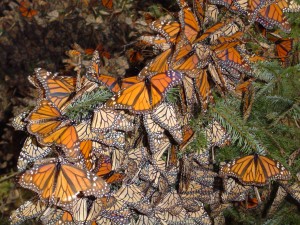
Thousands of monarchs in Mexico live as clusters on oyamel firs, their preferred winter habitat. Photo by Robert Wiedenmann.
This unique behavior makes monarchs vulnerable to environmental changes along the entire migration corridor. In some years, severe winter storms and heavy rains in Mexico have reduced the population by more than 80 percent.
“It’s killing them on both ends,” Gary says, summing up the problem.
The weather in Texas — the halfway migration point for most monarchs — is especially critical. Texas is where the monarchs rely on nectar to sustain their southbound journey, and where they start to lay eggs to build up the population during their northbound return.
“Climate change isn’t doing anything to the monarchs right now, but it will,” Taylor says. “By 2040, the temperature in Texas in March will be six degrees higher than it is now in the spring, and that will have a very devastating effect on the population.”
By December, the monarch reaches her destination in the mountains of Central Mexico. With thousands of monarchs from other northern origins, she will now form a dense butterfly cluster on an oyamel fir. In a microclimate maintained by an insulating canopy of these firs, she will spend most of the next 12 weeks in a semi-dormant state. She only interrupts her torpor to seek out water, which converts her stored abdominal fats into sugars, releasing energy for respiration.
Supporting native plants and wildlife
Since climate change is such a tough and long-term problem to tackle, short-term monarch conservation efforts have focused on habitat loss. Individuals like Gary and Darcy have turned their backyards into a milkweed paradise; nonprofits like Monarch Watch have spurred the federal government to support monarch conservation; and even some for-profit companies have realized the damage they have done: Monsanto is now donating more than $1 million to milkweed restoration.
“If we’re going to save this migration … it has to be a bottom-up as well as a top-down effort,” Taylor says. “We have already put ourselves in a massive hole with regard to monarch conservation. So now we need to figure out how to get out of that hole, and it’s going to take all of us pulling together to do that.”
To help keep monarchs in our future, Gary and Darcy are going above and beyond letting their land grow wild. During the 2015 season, they brought in more than 800 eggs and released 568 butterflies.
“That’s the highest number I’ve heard this year,” Taylor says.
The payback for their effort is a first-row seat for daily miracles.
“It’s so sweet; the caterpillar comes out of the egg and will actually eat the egg shell,” Darcy says. After this first meal, it proceeds to eat the leaf it was born on, growing quickly until it sheds — and then eats — its first skin. “I think it almost eats 24 hours a day. I don’t know that they actually sleep.”
During this stage, which lasts about two weeks, much of Darcy’s work involves cleaning up after the caterpillars: all that leaf-nibbling produces a stunning amount of poop. Darcy spends an average of two hours a day after work — sometimes four — making sure her darlings have enough milkweed to eat and stay clean and healthy while they continue to grow and shed their skins until they suddenly lose their interest in food.
“They’ll go to this leaf, to that leaf, and it’s like they’re looking for something,” Darcy says. Something in their body is telling them … I’m done eating. I want to go form my chrysalis.”
For this transformation into an inert pupa, or chrysalis, the caterpillar attaches itself to a flat surface. Ten days and a sprinkle of magic later, a beautiful butterfly emerges.
“Within 15 minutes, the wings are fully extended, but they’re wet,” Darcy says. “It takes about four hours for those wings to firm up … Once they are able to fly, they’re looking for light.”
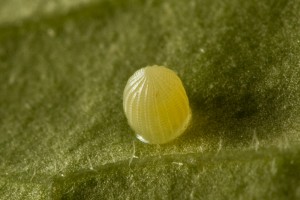
The monarch’s egg, about the size of a pinhead, includes all of the genes that will trigger its miraculous change into an adult butterfly. Photo by Eric Heupel, via Flickr/Creative Commons.
Gary and Darcy’s passion for nature does not end with butterflies. Their land supports many native species of birds, turtles, snakes, frogs, bees and other insects.
That passion has its price: “We have a hard time going on any vacations because there’s always something,” Gary says. “Whether it’s in the spring, we’re burning prairies and planting gardens, or in the fall, we’re collecting seeds. Summer, we’re taking care of monarchs. You get attached to the land.”
In February, the monarch is becoming more active, feeding on nectar in preparation for her return journey north. During this trip, her reproductive rest will end and she will start to mate, laying some 400 eggs scattered over 1,000 miles until she dies, perhaps somewhere north of Texas. Her generation won’t reach Wisconsin a second time, but their grandchildren will, soon laying their own eggs on the same milkweed plants in Gary and Darcy’s driveway that nourished their ancestors. And right around Memorial Day weekend, Gary will once again call for Darcy, showing off the first batch of eggs that signals the start of another summer.
See a slideshow of the monarch’s life cycle here.
For a full-screen version of the StoryMap below, click here.
